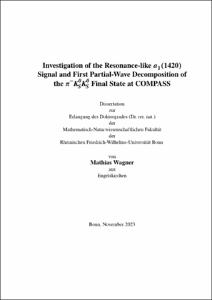Wagner, Mathias: Investigation of the Resonance-like a1(1420) Signal and First Partial-Wave Decomposition of the π -KS0KS0 Final State at COMPASS. - Bonn, 2024. - Dissertation, Rheinische Friedrich-Wilhelms-Universität Bonn.
Online-Ausgabe in bonndoc: https://nbn-resolving.org/urn:nbn:de:hbz:5-75936
Online-Ausgabe in bonndoc: https://nbn-resolving.org/urn:nbn:de:hbz:5-75936
@phdthesis{handle:20.500.11811/11513,
urn: https://nbn-resolving.org/urn:nbn:de:hbz:5-75936,
doi: https://doi.org/10.48565/bonndoc-273,
author = {{Mathias Wagner}},
title = {Investigation of the Resonance-like a1(1420) Signal and First Partial-Wave Decomposition of theπ -KS0KS0 Final State at COMPASS},
school = {Rheinische Friedrich-Wilhelms-Universität Bonn},
year = 2024,
month = apr,
note = {In 2014, a supernumerous light-meson state was found by the COMPASS collaboration. This discovery bore similarities to some of the XYZ states in the heavy-meson sector, discovered ate+e - colliders, that did not fit the expectations from the quark model and hence were called exotic states. The partial-wave decomposition of the COMPASS data for the π -π+π - final state, which is employing an isobar model, revealed a narrow signal with axial-vector quantum numbers in the f0(980)π P-wave . Since it was found at an energy of 1.4 GeV by a resonance-model fit with a relativistic Breit-Wigner model, it was called a1(1420). This thesis investigates the nature of the signal, following two avenues.
In the first part, it is shown how a rescattering of final-state particles can produce such a signal by explicitly performing a projection of a K*K intermediate state to the f0(980)π final state. The resulting theoretical model is fitted to the COMPASS data and the quality is compared to a fit using a conventional relativistic Breit-Wigner model. Several systematic studies are performed. This includes a fit to each of the systematic studies of the underlying partial-wave decomposition, as well as a bootstrap analysis and modifications of the theoretical model. In all cases except one, the rescattering interpretation shows a better compatibility with the data.
In the second part, an event selection of the complementaryπ -KS0KS0 final state is performed, where the optimal vertex separation for the KS0 mesons is determined by means of a significance study to reduce background coming from a possible 5π final state. A total of ~240000 exclusive events are selected, superseding the statistics of previous experiments of diffractive π -KS0KS0 production by a factor of ~240. Based on the selected data set, a first partial-wave decomposition is performed, revealing strong evidence for the a1(1420) signal in the f0(980)π P-wave of the π -KS0KS0 final state in form of an enhancement in the intensity and a phase motion in the relative phase to other waves, even for both resonance-spin projections M=0 and M=1. At the same time, no resonance-like signal is visible at ~1.4 GeV in the K*(892)KS0 S-wave, which agrees well with the interpretation of a rescattering effect. The spin-exotic π1(1600), a candidate for the lightest hybrid meson, manifests itself as a broad peak in the K*(892)KS0 P-wave, however, no significant evidence for a relative phase motion with other partial waves is observed. Another hybrid candidate with ordinary quantum numbers, the pseudoscalar π(1800), shows up as a clean narrow peak in the f0(980)π S-wave. It is accompanied by a narrow resonance-like signal at 1.4 GeV , i.e. an enhancement in the intensity together with phase motion in the relative phase to other partial waves. This could be the first observation of a "π(1420)" rescattering effect, similar to the a1(1420), but with pseudoscalar resonance quantum numbers.},
url = {https://hdl.handle.net/20.500.11811/11513}
}
urn: https://nbn-resolving.org/urn:nbn:de:hbz:5-75936,
doi: https://doi.org/10.48565/bonndoc-273,
author = {{Mathias Wagner}},
title = {Investigation of the Resonance-like a1(1420) Signal and First Partial-Wave Decomposition of the
school = {Rheinische Friedrich-Wilhelms-Universität Bonn},
year = 2024,
month = apr,
note = {In 2014, a supernumerous light-meson state was found by the COMPASS collaboration. This discovery bore similarities to some of the XYZ states in the heavy-meson sector, discovered at
In the first part, it is shown how a rescattering of final-state particles can produce such a signal by explicitly performing a projection of a K*K intermediate state to the f0(980)π final state. The resulting theoretical model is fitted to the COMPASS data and the quality is compared to a fit using a conventional relativistic Breit-Wigner model. Several systematic studies are performed. This includes a fit to each of the systematic studies of the underlying partial-wave decomposition, as well as a bootstrap analysis and modifications of the theoretical model. In all cases except one, the rescattering interpretation shows a better compatibility with the data.
In the second part, an event selection of the complementary
url = {https://hdl.handle.net/20.500.11811/11513}
}






